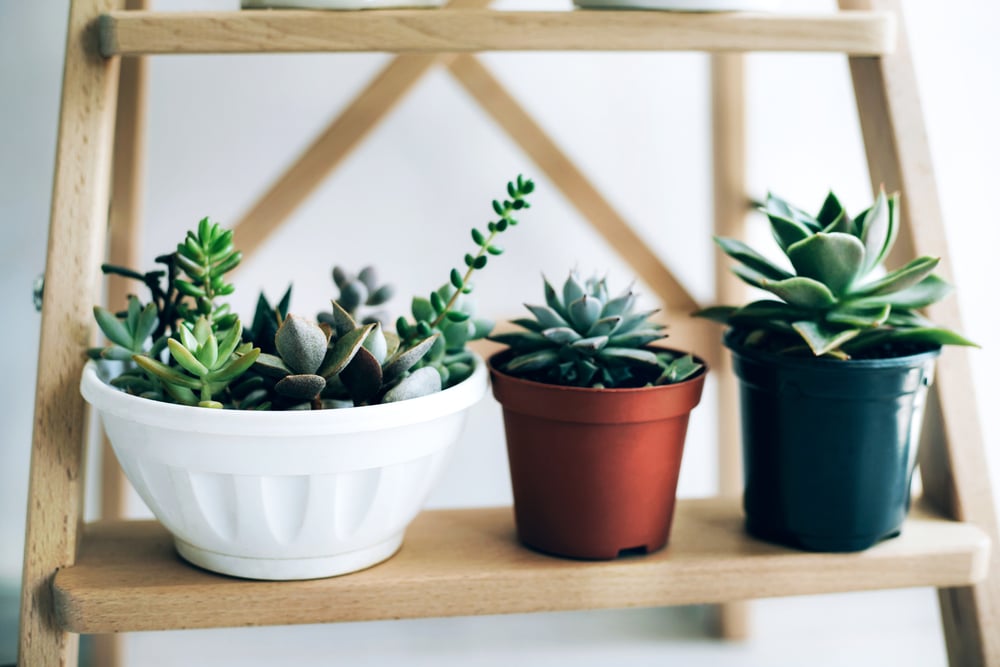Did you know that not all succulents need full sun and desert climates? In fact, there are plenty of species that will thrive in dim places.
Add in the fact that they require very little water or tending and you have a great low-maintenance addition to any light-compromised home, yard, or workspace!
1. Aloe
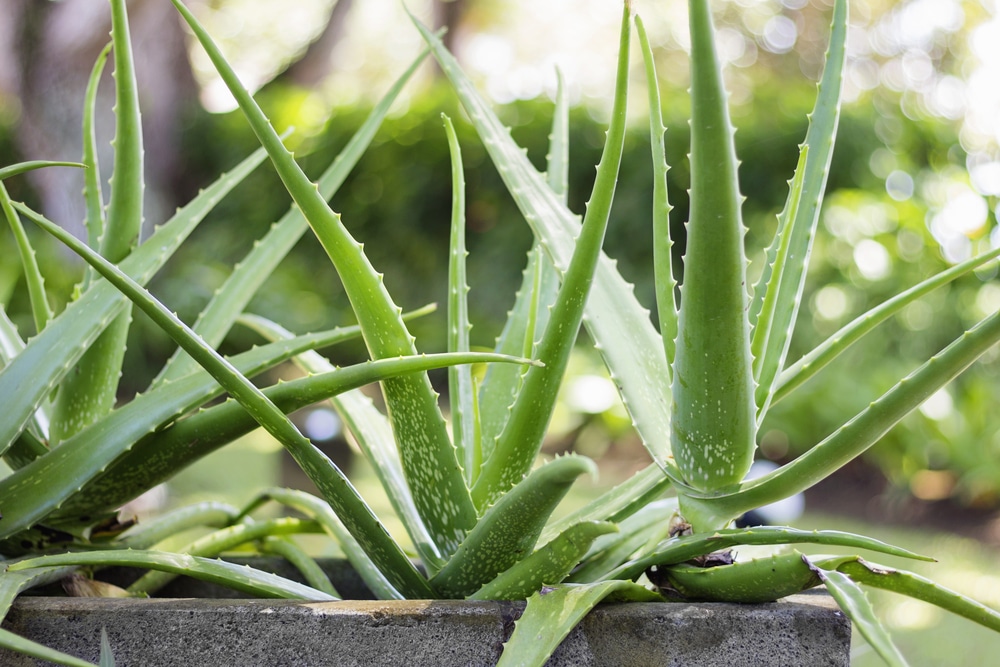
Easily recognized by its pointed, fleshy leaves, Aloe is a great starting place for anyone new to the succulent world.
Although it responds best to strong sun and can grow over 3 feet tall outdoors, it’s just as happy as a potted houseplant.
Surprisingly hardy in partial shade and even artificial light, it’s a great solution for low-lit offices.
The most popular variety, Aloe Vera, also has soothing and moisturizing properties. Cut an outer leaf at its base to access the gel and enjoy this added perk.
Aloe Care
Can tolerate a broad spectrum, from full sun to partial shade or artificial light. Water every three weeks (less in winter months) and drain well. This plant benefits from a succulent-specific potting mix.
- Light: Full sun to partial shade
- Water: Drought tolerant/ low water needs
- Degree of difficulty: Easy
2. Snake Plant

Popularly known as the “Snake Plant”, this architectural succulent has sharp and slender leaves that grow in clusters several feet high.
Virtually indestructible, it’s a perfect match for beginners looking for a species that is extremely forgiving of infrequent watering and can succeed in very dim lighting.
Also a natural air-purifier, the Snake Plant makes a great addition to a bedroom for its nighttime oxygenation benefits.
Sansevieria Care
Can tolerate filtered sun as well as very low light or artificial light. Water once a month (less frequently in humid climates) and be sure that it thoroughly drains and dries between watering. This plant can be satisfied with an all-purpose potting soil.
- Light: Filtered sun to low light
- Water: Drought tolerant/ low water needs
- Degree of difficulty: Easy
3. Crassula Ovata
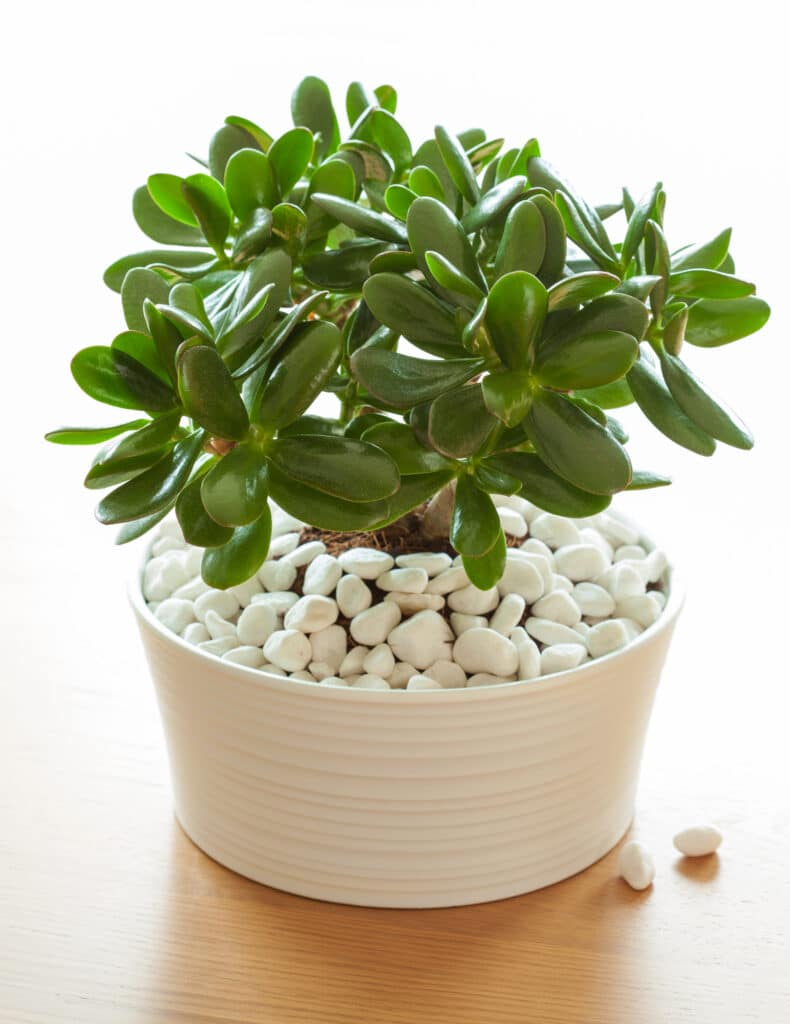
Also known as the “Jade Plant” (said to bring fortune to all who own one!) this grows tough, trunk-like shoots and easily adapts to a variety of light conditions.
Its clumps of shiny green leaves retain moisture and make watering pretty fool proof: If the leaves are plump and glossy, all is well; If the leaves begin withering or falling, a drink will quickly revive them.
Jade Plant Care
Can tolerate a broad spectrum, from full sun to partial shade or low light. Water once a month (every 3 weeks in full sun or during summer months) and drain well. This plant benefits from a succulent-specific potting mix.
- Light: Full sun to partial shade
- Water: Drought tolerant/ low water needs
- Degree of difficulty: Easy
4. Rebutia
The “Crown Cactus” is known by its spiny, spherical shape and the bright flowers that form at its base. This is a frequent choice for home containers because of its simple maintenance: All the Crown Cactus asks is that it be kept from high heat and not over-watered. The balls replicate quickly, forming large clusters, and although many succulents have trouble producing blooms indoors, this one flowers easily.
Rebutia Care
Can tolerate both full sun and partial shade but prefers moderate heat. Water thoroughly and drain well, allowing soil to fully dry between watering. This plant benefits from a succulent-specific potting mix.
- Light: Full sun to partial shade
- Water: Drought tolerant/ low water needs
- Degree of difficulty: Easy
5. Senecio Rowleyanus
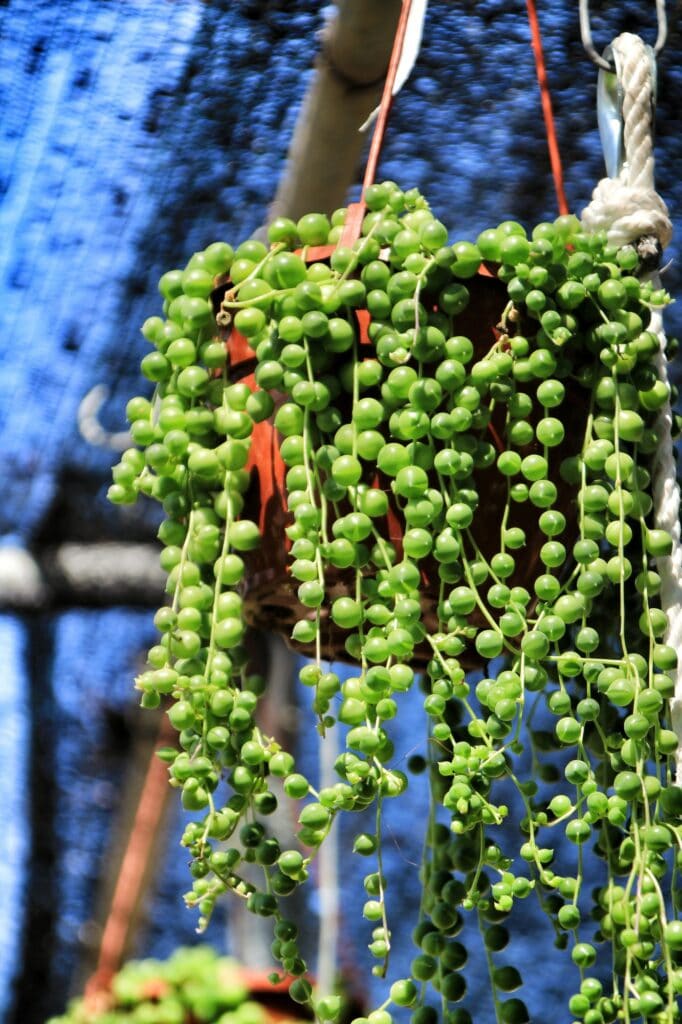
Commonly called “String of Pearls” for its signature strands of pea-shaped leaves, this succulent is a popular for its eye-catching growths and low-maintenance care.
It can be grown in a hanging basket to enjoy the long vines or it can be grown flat as a ground cover.
If it is to serve as ground cover, be aware that the String of Pearls is sensitive to high heat, frost and over saturation from rain, so planting in a covered area is recommended. With proper light conditions during the summer, it may produce white, spice-scented flowers.
Senecio Rowleyanus Care
Indirect sun is best but can adapt to lower light. Water once a month and drain well, allowing it to dry completely between watering. This plant benefits from a succulent-specific potting mix.
- Light: Indirect sun to low light
- Water: Drought tolerant/ low water needs
- Degree of difficulty: Easy
6. Senecio Radicans

This “String of Bananas” is true to its name, featuring long trails of plump, curled leaves. Fast growing and easy to maintain, it is not unusual for its vines to reach a length of at least 3 feet and occasional trimming will encourage the strands to split for fuller growth. Given enough light, it will give way to small, sweet-smelling flowers in fall and winter.
Senecio Radicans Care
Performs best in medium light or partial shade. Water once a month and drain well, allowing it to dry completely between watering. This plant benefits from a succulent-specific potting mix.
- Light: Medium light to partial shade
- Water: Drought tolerant/ low water needs
- Degree of difficulty: Easy
7. Cleistocactus Strausii

Also known as the “Silver Torch Cactus” this plant is loved for its spiny, white, architectural columns. Simple to care for and sensitive to high heat, it is an ideal choice for potting indoors. Although it can tolerate lower light, exposure to full summer sun will produce red blooms that are a favorite among hummingbirds.
Cleistocactus Strausii Care
Full sun is best but can adapt to light shade. Water once a month and allow it to dry completely between watering. This plant benefits from sandy, well-drained soil.
- Light: Full sun to light shade
- Water: Drought tolerant/ low water needs
- Degree of difficulty: Easy
8. Haworthia Margaritifera

This “Zebra Cactus” grows in tufted, deep-green rosettes that are ringed with white dots, giving it its signature stripes. It is a cousin of Aloe and offers the same adaptability and ease of care. In their native environment, the Zebra Cactus prefers the shade of rocks and moderate heat and therefore does very well as a houseplant.
Haworthia Margaritifera Care
Low light/ filtered sun is best, as this species burns easily in bright sun. Water once a month at the base of the plant, drain well and allow to dry between watering. This plant benefits from a succulent-specific potting mix.
- Light: Filtered sun to low light
- Water: Drought tolerant/ low water needs
- Degree of difficulty: Easy
9. Agave Attenuata
This “Foxtail” Agave is a favorite among landscapers for its drought -friendliness and dramatic presence; One rosette can grow up to 5 feet tall and 8 feet wide and exhibits bushy stalks (hence the name!) that bloom in summer and extend upwards of 10 feet high. A showpiece in any garden, it also does well in decorative pots on patios and balconies and is most appreciated for being spineless, unlike most Agave species.
Agave Attenuata Care
Can tolerate both sun and shade and prefers moderate temperatures (does not do well in high heat). Water every two weeks or when completely dry. This plant performs best in sandy, well-drained soil.
- Light: Full sun and partial shade
- Water: Drought tolerant/ low water needs
- Degree of difficulty: Easy
10. Kalanchoe Tomentosa

Its plush and silvery, dark-rimmed leaves lend this succulent the nickname “Panda Plant”. This is a popular choice for anyone seeking a little height in their collection; With enough space, it can grow up to 2 feet high. Although very low-maintenance, the Panda Plant’s clusters are sensitive to the cold, making this a great option for indoor containers.
Kalanchoe Tomentosa Care
Can tolerate both full sun and partial shade. Water thoroughly once a month and allow to drain and dry between watering. This plant benefits from a succulent-specific potting mix.
- Light: Full sun and partial shade
- Water: Drought tolerant/ low water needs
- Degree of difficulty: Easy
11. Zamioculcas Zamiifolia
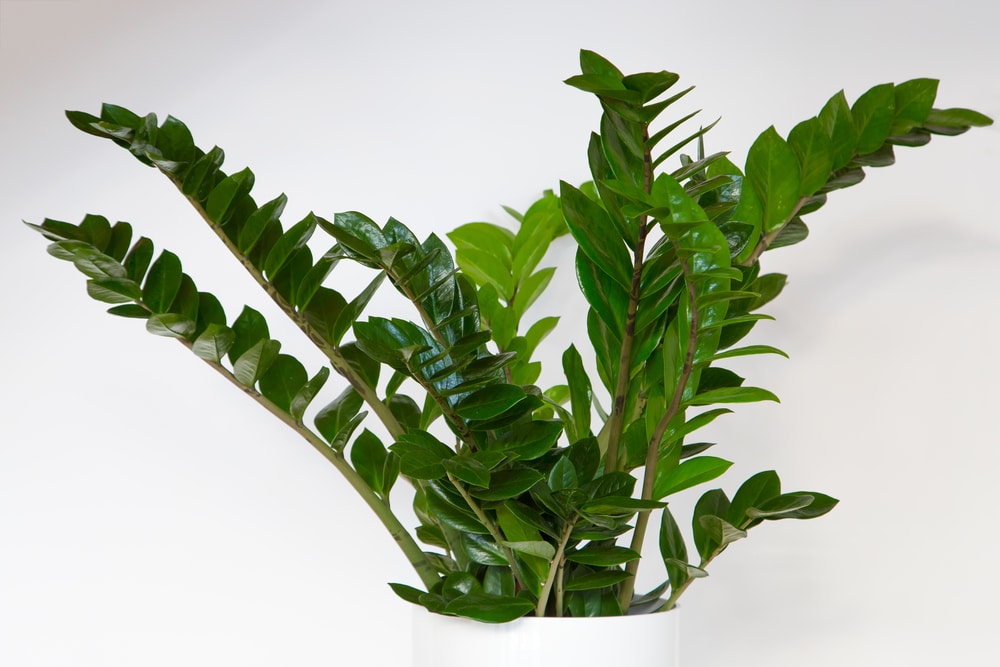
Commonly called the “ZZ Plant”, this plant thrives on such little water that beginners are generally advised to forget to take care of it.
Its firm stalks and waxy, deep green leaves are exceptionally hardy, withstanding a variety of temperatures and performing well in extremely low – even artificial – lighting, which make it a perfect choice for windowless spaces. And if you need another reason to pick one of these plants up – the ZZ plant is easy to propagate!
Zamioculcas Zamiifolia Care
Can tolerate a broad spectrum, from bright indirect sun to low light or fluorescent light. Water once a month only if soil is dry and drain well. When in doubt, leave it dry longer than feels comfortable! This plant can be satisfied with an all-purpose potting soil.
- Light: Indirect sun to low or artificial light
- Water: Drought tolerant/ low water needs
- Degree of difficulty: Easy
12. Gasteria
Often called “Ox Tongue” for its flat, tongue-like leaves with bumpy surface texture, this succulent produces long stems of small, sack-like flowers whose shape inspired its genus name (derived from the Latin word for “stomach”).
A great choice for indoor containers, it also does well outside in cooler temperatures and climates that have some rain, although proper cover is critical in that case: Ox Tongue is quick to rot if water collects in its leaves.
Gasteria Care
Can tolerate bright, filtered sun as well as partial shade or low light. Water consistently every 3 weeks in summer and every other month in winter. Water the base of the plant to avoid moisture between the leaves and drain well. This plant benefits from a succulent-specific potting mix.
- Light: Filtered sun to low light
- Water: Drought tolerant/ low water needs
- Degree of difficulty: Moderate
13. Kalanchoe Blossfeldiana

The “Flaming Katy” is well-loved for its bushy, scalloped leaves and bright blooms that can repeat year-round and last for over a month at a time. Although able to grow outdoors, this tropical plant does particularly well inside because of its aversion to cold. Its evergreen leaves are easy to maintain with little care; however, with extra attention to moisture, temperature and pruning, the Flaming Katy’s blooms will flourish again and again.
Kalanchoe Blossfeldiana Care
Can tolerate bright sun as well as partial shade or low light. Soil should be kept lightly moist with careful attention not to over-water. Pinch off dead blooms to encourage repeated flowering. This plant benefits from a succulent-specific potting mix.
- Light: Bright sun to low light
- Water: Medium water needs
- Degree of difficulty: Moderate
14. Echeveria Agavoides

Characterized by bright green rosettes that grow low to the ground, the most loved variety is the “Lipstick” because of the brilliant red hue that paints each of its leaves. While easy to maintain indoors, the Lipstick Echeveria multiplies quickly in gardens, creating large clusters that make an attractive, easy-to-maintain ground cover. With sufficient sun in spring and summer, it will also produce delicate flowering shoots.
Echeveria Care
Can tolerate bright sun as well as partial shade. Water once a month, only if soil is completely dry (can go up to 3 months without watering depending on the sun exposure). This plant benefits from rocky, well-drained soil.
- Light: Bright sun to partial shade
- Water: Drought tolerant/ low water needs
- Degree of difficulty: Moderate
15. Rhipsalis cereuscula

Also known as “Mistletoe Cactus” for the white berry-like fruits that it forms in summer, this species grows in strands are stick-like when short and become hairy in appearance as they get longer. Mistletoe Cactus is tropical, accustomed to shady spots and humidity, making it a great choice for a bathroom. It requires more water than the average succulent while also being highly susceptible to root rot if overwatered so a close eye on the moisture level is recommended.
Rhipsalis cereuscula Care
Low light/ filtered sun is best, as this species burns easily in bright sun. Water whenever soil is dry to the touch and pay special attention to drainage. This plant benefits from a succulent-specific potting mix.
- Light: Filtered sun to low light
- Water: Medium water needs/ humidity
- Degree of difficulty: Moderate
16. Hoya Obovata
This variety of the “Wax Plants”, named for their glossy, deep green vines, is the most adaptable of its family. As long as it’s kept relatively warm, it does well in medium light and is very forgiving of variable climates and infrequent watering. If you can spare more sun, the Wax Plant will likely thank you with fragrant white blooms.
Hoya Obovata Care
Indirect sun is best but can adapt to lower light. Keep soil lightly moist and humid but well-drained; when in doubt, better to let it dry out between watering. This plant benefits from a succulent-specific potting mix.
- Light: Indirect sun to low light
- Water: Medium water needs/ humidity
- Degree of difficulty: Moderate
17. Parodia Haselbergii

Also called the Scarlet Ball Cactus, this plant is loved for its woolly globes and bright reddish-orange flowers that sprout from winter through spring. It appreciates more moisture than most succulents so a light misting from time to time is helpful. With a little space, it will easily replicate and create clusters.
Parodia Haselbergii Care
Can tolerate partial shade and indirect light; is susceptible to scorching in full sun. Keep moist but well-drained during spring and summer and drier during fall and winter. This plant benefits from a succulent-specific potting mix.
- Light: Indirect sun to partial shade
- Water: Medium water needs
- Degree of difficulty: Moderate
18. Beaucarnea Recurvata

The “Ponytail Palm Tree” is often a conversation piece, with its unusually thick trunk and long fronds that cascade to the floor. A little patience is needed with this one; it’s a slow grower and, although it can handle a range of temperatures and its trunk holds water effectively, it will perform best if given some thoughtful attention to moisture and light conditions.
Beaucarnea Recurvata Care
Indirect sun is best but can tolerate lower light. Water thoroughly once a week or whenever dry. If tips are browning, increase the humidity. This plant benefits from sandy, well-drained soil.
- Light: Indirect sun to low light
- Water: Medium water needs/ humidity
- Degree of difficulty: Moderate
19. Haworthia Cymbiformis

The pillowy, evergreen rosette of this “Cathedral Window” plant is noted for its translucent, glass-like tips. It easily reproduces into clusters that make effective ground cover but it can also be potted indoors with ease and great effect. Given enough sun, it will sprout tall white flowers in early summer.
Haworthia Cymbiformis Care
Can tolerate full sun to partial shade. Keep soil lightly moist during summer and water sparingly during winter months. This plant benefits from a succulent-specific potting mix.
- Light: Full sun to partial shade
- Water: Medium water needs
- Degree of difficulty: Moderate
20. Euphorbia Tithymaloides

Named “The Devil’s Backbone” for its pointed red flowers, this relatively low-maintenance evergreen reaches up to 15 feet outside but can also be potted and kept indoors. It prefers shade and is drought tolerant, making it a great choice for a houseplant; however, it’s unlikely to flower indoors without strategic lighting and moisture.
Euphorbia Tithymaloides Care
Can tolerate both full sun and full shade and is hardy at lower temperatures. Water every two weeks, keeping soil very lightly moist. This plant benefits from sandy, well-drained soil.
- Light: Full sun to full shade
- Water: Medium water needs
- Degree of difficulty: Moderate
21. Asplenium Nidus
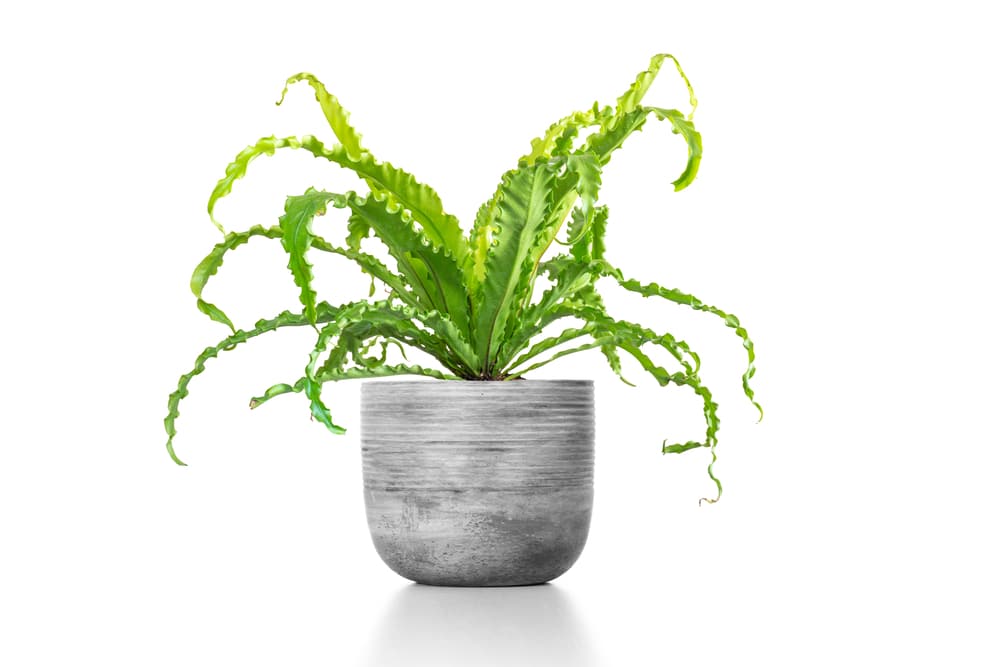
Also known as a “Bird’s Nest” fern, this leafy plant has pleated fronds that add a sculptural element to any space. It demands a bit more water than most, thriving in low light and humidity and responding best in kitchens and bathrooms. This plant is also notable for naturally purifying and oxygenating the air.
Asplenium Nidus Care
Does best infiltered light or low light and prefers warm temperatures. Water often to keep soil moist and spritz fronds as needed to maintain humidity. This plant can be satisfied with an all-purpose potting soil.
- Light: Filtered sun to low light
- Water: Medium water needs/ humidity
- Degree of difficulty: Moderate
22. Cotyledon Tomentosa

This shrubby “Bear Paws” plant earns its name from its thick, fuzzy leaves and their rigged “claws”. With growth up to 2 feet wide, this is a popular landscaping choice; however, it prefers warmer climates, which can make it a better fit indoors. With enough sun, it will produce orange flowers in the spring.
Cotyledon Tomentosa Care
Can tolerate full sun to partial shade. Water thoroughly once a month and allow to drain and dry between watering. This plant benefits from a succulent-specific potting mix.
- Light: Full sun to partial shade
- Water: Drought tolerant/ low water needs
- Degree of difficulty: Moderate
23. Sedum Morganianum

Also called the “Burro’s Tail”, this is unique for its bushy stems that can grow as long as 4 feet. Its natural tendency to trail makes it a great choice for hanging baskets, although the tiny, overlapping leaves are delicate and best protected from wind. This rarely blooms, but when it does, it produces small, star-shaped flowers whose nectar is highly desirable to bees.
Sedum Morganianum Care
Performs best in indirect sun or lower light. Water thoroughly once a month and allow to drain and dry between watering. This plant benefits from a succulent-specific potting mix.
- Light: Indirect sun to low light
- Water: Drought tolerant/ low water needs
- Degree of difficulty: Moderate
24. Schlumbergera
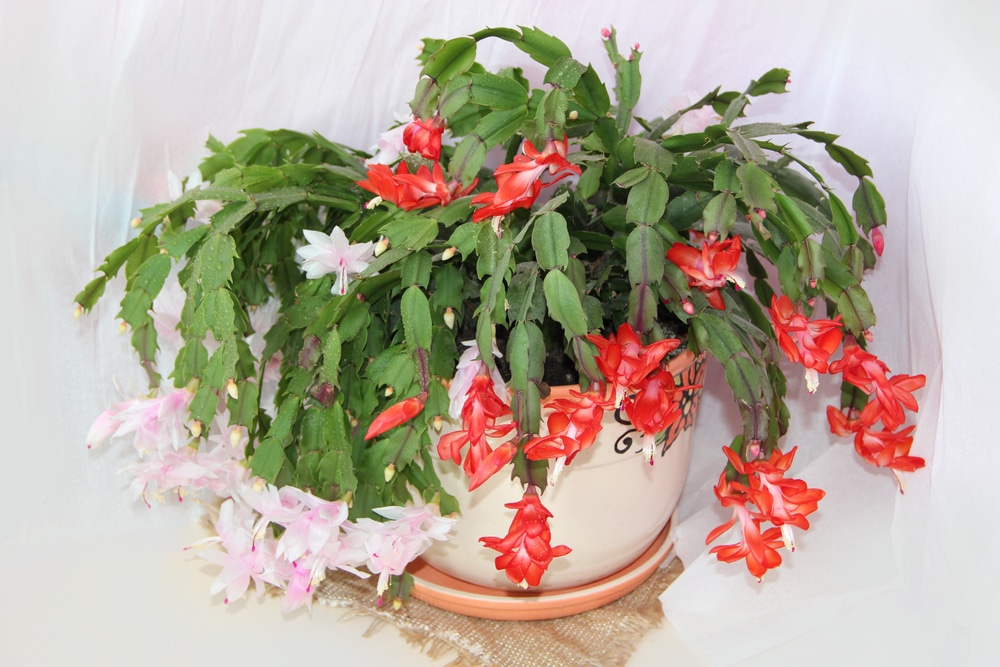
Known by most as the “Christmas Cactus”, this plant is recognized by its long green stems and bright (typically red) flowers that can be encouraged to bloom during the holiday season. Native to rainforests, it requires low light and humidity and makes a great challenge for seasoned growers, as it can be temperamental if a delicate moisture balance isn’t maintained.
Schlumbergera Care
Indirect sun is best but can adapt to lower light. Keep soil lightly moist, maintain humidity but be aware of drainage, as it is sensitive to over-watering. Blooming is contingent on strategic attention to fertilizer, temperature and light conditions. This plant benefits from a succulent-specific potting mix.
- Light: Indirect sun to low light
- Water: Medium water needs/ humidity
- Degree of difficulty: Difficult
25. Euphorbia Milii
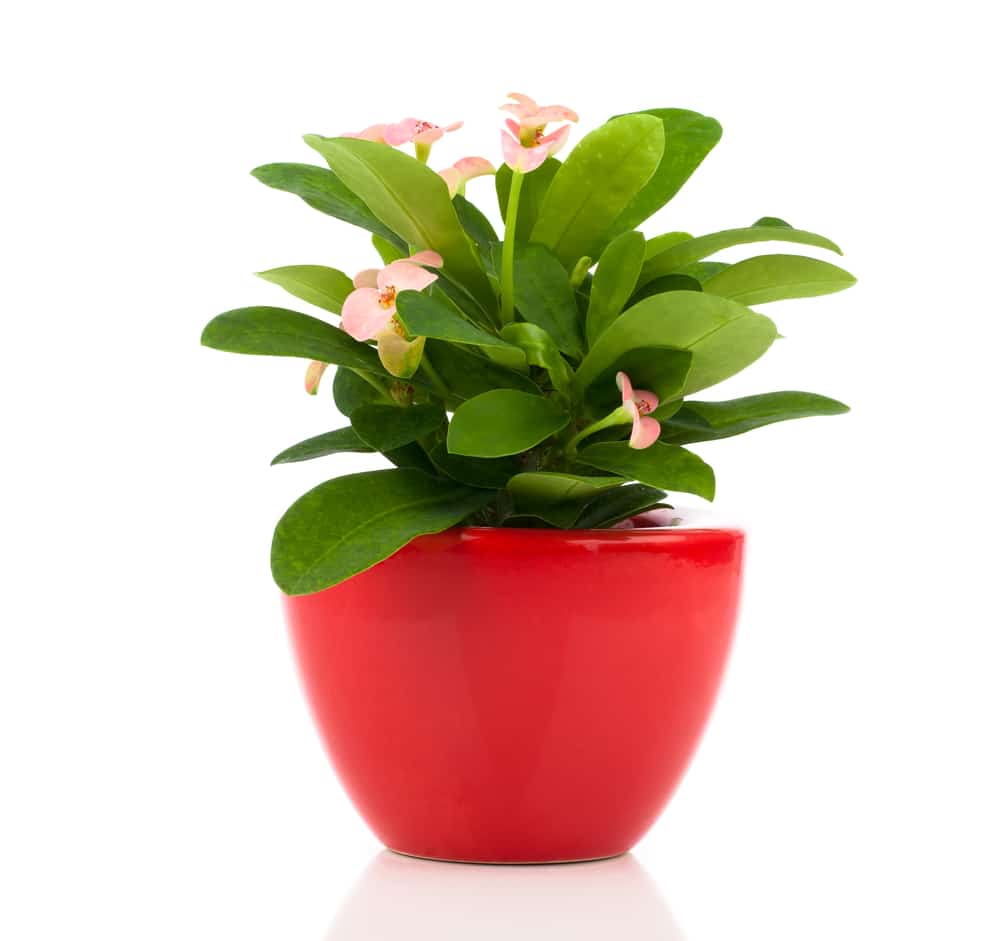
Known as “Crown of Thorns”, this succulent shrub produces highly ornamental, thorny, deep green stems with red flowers and is fabled to have been used to fashion crowns throughout its history. When grown outside, it’s been known to expand up to 20 feet; however, with diligent pruning or repotting (careful of the thorns!), it can also be contained as a houseplant. Flowering is contingent on careful attention to light levels both day and night.
Euphorbia Milii Care
Can tolerate both full sun and partial shade.Water every two weeks with careful attention not to collect moisture in the blooms and dry fully between watering. This plant benefits from sandy, well-drained soil.
- Light: Full sun to partial shade
- Water: Medium water needs
- Degree of difficulty: Difficult
